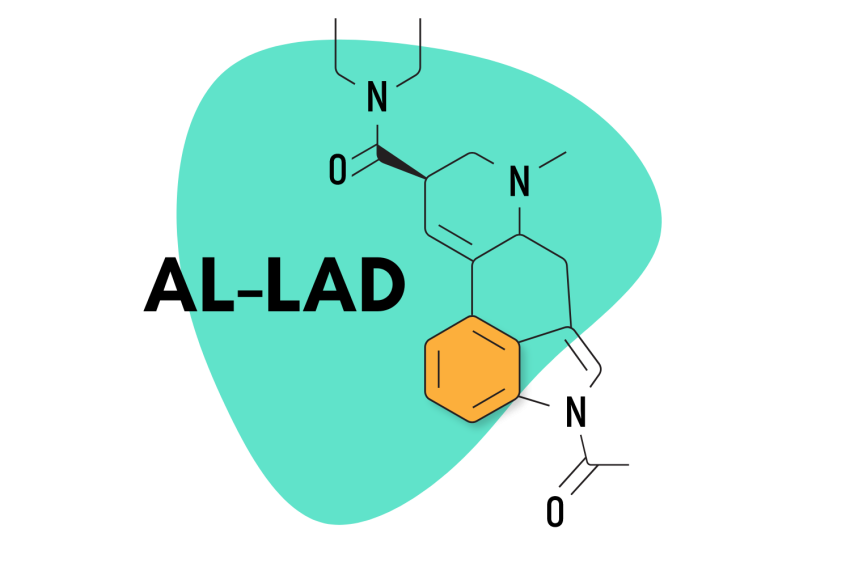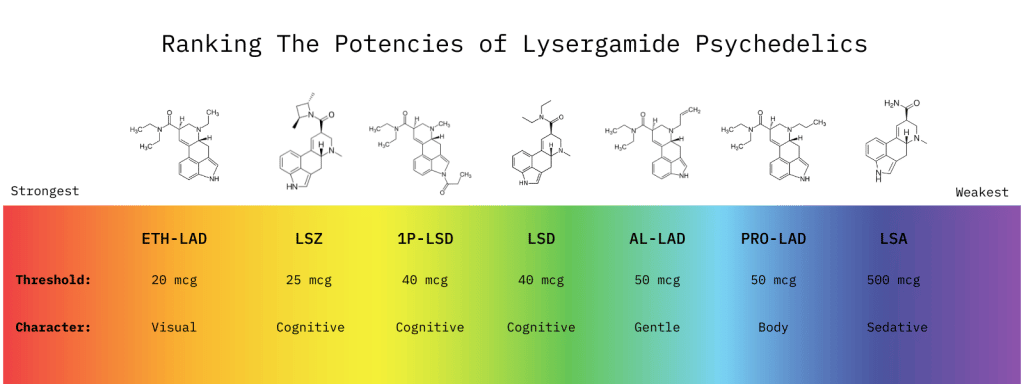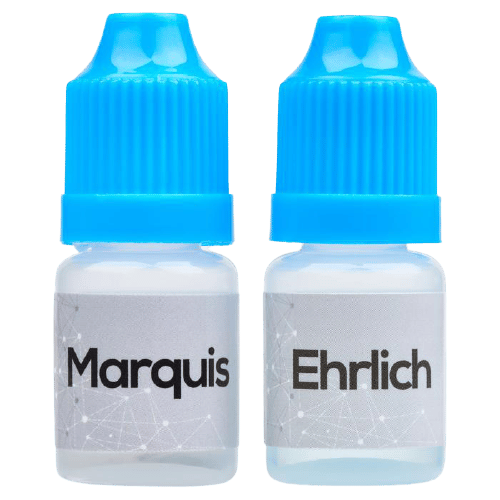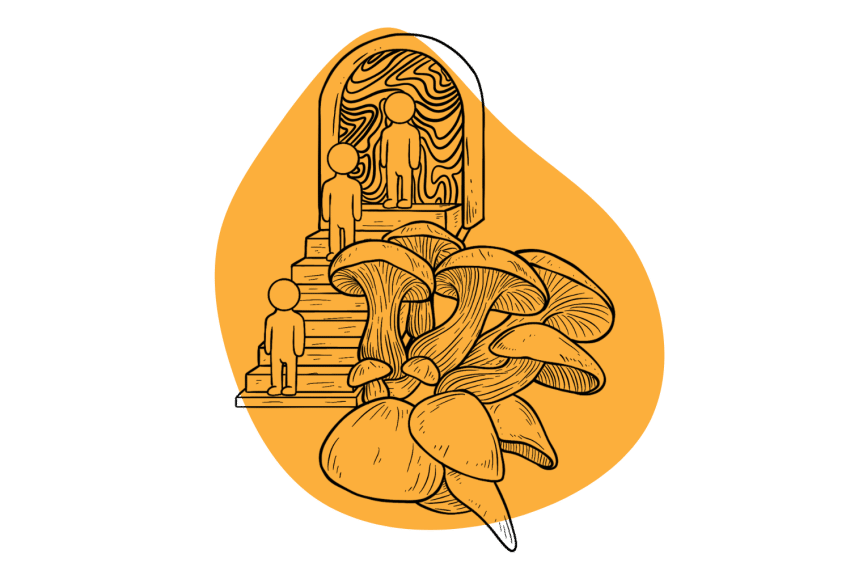AL-LAD: Is This “Friendly” Acid Alternative Legit?
AL-LAD is a lysergamide derivative of LSD.

Few psychedelics have even come close to being as popular as LSD (lysergic acid diethylamide). Over the years, chemists have been busy trying to find alternatives to LSD that can offer similar hallucinogenic effects.
AL-LAD is one of these chemicals. It’s unclear where this psychedelic first came from, but after hitting the research chemical market in 2013, its popularity has only continued to grow.
Learn everything you need to know about AL-LAD, including information on dosage, safety, and comparisons with similar psychedelics like LSD or psilocybin.
What is AL-LAD?
AL-LAD is the abbreviated term for N6-allyl-6-norlysergic acid diethylamide. It’s classified as a semi-synthetic indole alkaloid that shares a similar structure to LSD and other analogs like ETH-LAD, PRO-LAD, 1P-LSD, LSZ, and others.
Like its sister chemicals, AL-LAD is a formidable psychedelic. It’s capable of producing intense visual and auditory hallucinations, introspective thinking, ego-dissociation, and out-of-body experiences.
Using LSD as the baseline, AL-LAD is slightly weaker, more visual, and less introspective. It’s often recommended as a good “starter psychedelic” because the experience tends to be less intense from an existential standpoint compared to most psychedelics.
AL-LAD has been around since at least the early 70s. It was first reported by a Japanese research paper published in May of 1976 [3]. This paper identified a series of nor-lysergic acid derivatives.
The first study exploring the effects of AL-LAD was published in 1984 by Dr. David E Nichols and his team at Purdue University [2]. Nichols was exploring the effects of AL-LAD compared to LSD. The study ultimately reported this compound was 2 or 3 times as strong as LSD, but this has since been disproven. AL-LAD is considered to be the same or slightly less potent than LSD [1].
AL-LAD was later included in a book written by the late Alexander Shulgin — TiHKAL (1997) — where he synthesized and self-tested various indoleamine psychedelics and recorded his findings.
It wasn’t until several decades later, in 2013, that AL-LAD first entered the research drug market. It was marketed as “legal LSD” along with several other members of the lysergamide family of drugs. This substance was most popular in the United Kingdom and Ireland until it was banned in 2015.
AL-LAD: Specs & Technical Details
| Active Ingredient | 6-allyl-6-nor-LSD |
| Level of Risk | Low |
| Other Names | Aladdin |
| Most Common Side Effects | Anxiety & paranoia |
| Duration of Effects | 6–8 Hours |
| Legality | Illegal in most countries |
Guidelines for the Responsible Use of AL-LAD
- 🐍 I understand why psychedelics should be treated with respect
- ⚖️ I’m familiar with the laws for AL-LAD in my country & state
- 🍄 I’m familiar and confident in the dose I’m taking (dose range for AL-LAD is 80–200 mcg)
- 🧪 I’ve tested a sample of the substance I’m using with a drug testing kit
- 💊 I’m not mixing any medications or other substances with AL-LAD
- 🏔 I’m in a safe & comfortable environment with people I trust
- 🐺 One of the members of my group is responsible and sober (AKA a trip sitter)
- ⏳ I have nothing important scheduled for after the trip
- 🧠 I’m in a sound & healthy state of mind
- 📚 I’m familiar with the four pillars of responsible psychedelic use — set, setting, sitter, & substance.
- ⏳ Know the timeline — the effects of AL-LAD can last between 6 and 8 hours.
- 🙅♀️ Know when to avoid lysergamides — don’t take AL-LAD if you have underlying heart, neurological, or psychiatric disorders.
What’s The Dose of AL-LAD?
The dose of AL-LAD is slightly higher than LSD at around 40 micrograms for a threshold dose. As reported by Alexander Shulgin, the standard dosage range for psychoactive effects is between 80 and 160 micrograms. Since this report, the standard dose was raised to around 200 micrograms on the high-end.
There are plenty of AL-LAD trip reports online, with users taking up to 300 micrograms. While the experience is intense at these higher doses, AL-LAD never quite leads to out-of-body experiences or some of the deeper and more challenging experiences brought on by substances like DMT (N,N-dimethyltriptamine).
The doses of AL-LAD include:
- Microdose — 10–20 mcg
- Threshold dose — 40 mcg
- Standard psychoactive dose — 80–200 mcg
- Heroic dose — 200–300 mcg
Microdosing AL-LAD
The practice of microdosing involves taking sub-perceptual doses of a psychedelic compound over an extended period of time. The most common substances used for microdosing are magic mushrooms and LSD, but analogs to LSD like AL-LAD or 1P-LSD also make for great microdosing candidates.
In general, a microdose is around 10% of the standard psychoactive dose. So with a dose range of 80 to 200 mcg, a microdose for AL-LAD would be somewhere between 10 and 20 mcg.
At this dose, there should be no alterations in visual or auditory perception (no hallucinations), but there may be some change in emotion, introspection, creativity, ability to focus, or other subtle changes.
The most common microdosing schedule is to take one dose, followed by two days without a dose, and repeat.

What Does AL-LAD Feel Like?
In a blind test, most people wouldn’t be able to tell the difference between AL-LAD and LSD.
The effects are virtually identical when taken at the same dose. Experienced psychonauts often claim AL-LAD is ever so slightly weaker than LSD, and the experience has a greater visual emphasis and less introspective or existential thought patterns.
This is one reason why AL-LAD and related nor-LSD derivatives like PRO-LAD are considered a better choice for people using psychedelics for the first time.
Alexander Shulgin was particularly fond of this psychedelic. In his book, TiHKAL, he suggests the following regarding the effects of this substance: “[AL-LAD] is simply beautiful. Erotic and music absorption after the second hour. Clear thinking with superb imagery and good interpretation. Easy, gentle sleeping. The next day, serene, clear-thinking peacefulness. One of the best materials ever.”
Most AL-LAD trip reports have more positive sentiment than negative. This is likely a result of its milder introspective qualities, which can bring up some uncomfortable thoughts and emotions in people who aren’t ready to face them.
With that said, AL-LAD, like any other psychedelic, is highly dependent on your own thoughts and emotions. The direction the trip will take depends on how you’re feeling, the environment you spend your time in during the trip, the people you’re with, and the thoughts and ideas present in your imagination.
It doesn’t matter what psychedelic you’re using; you should always treat your psychedelics with respect. Follow our guide to responsible psychedelic exploration for more information on how to stay safe and minimize your chances of having a “bad trip.”
How Long Does AL-LAD Last?
AL-LAD lasts somewhere between 6 and 8 hours in total. It can take about 45 minutes for the effects to first appear after taking it, and the peak occurs somewhere around the 2-hour mark.
The peak experience remains for about 2 hours before slowly starting to taper off over the next 2–4 hours.
Most people report feeling enhanced mental clarity (afterglow) lasting several days after the experience. This effect is also noted in people who microdose AL-LAD.
How to Take AL-LAD
AL-LAD is extremely potent. Less than a single milligram is enough to produce a vivid psychedelic experience. The active dose is less than a single drop of liquid, which makes it difficult to measure doses accurately.
The solution is to soak a special type of highly absorbent paper called blotting paper with AL-LAD, then cut it into very small squares to provide the correct dose. This is the same method used for dosing LSD and related derivatives.
To use blotter paper, you can place it under your tongue and hold it there for a few minutes before swallowing, or add it to a piece of gum and chew it for a while before you swallow.
You can also drop a blotter containing AL-LAD into some water or juice to allow it to dissolve before you drink it. This is a good way of splitting a few doses among several people. For example, say there are five people and only four tabs of AL-LAD. You can drop all four into some water, wait for it to dissolve, and then split the water among all five people.

How Strong is AL-LAD Compared To Other Psychedelics?
AL-LAD is most comparable to LSD, 1P-LSD, LSA, LSZ, ETH-LAD, and PRO-LAD. The experience of all these psychedelics is virtually identical, if not for some minor subjective differences.
To help understand the hierarchy of lysergamide potency, here’s a list of each of these compounds and their distinct characteristics in order of the most potency to the least potent:
- ETH-LAD — Comparable to AL-LAD, but noticeably stronger and with a more intense body load.
- LSZ — Produces a slightly more intense experience than AL-LAD but shares the same qualities.
- LSD — Very similar experience to AL-LAD, but slightly stronger and more introspective.
- 1P-LSD — Virtually identical experience to AL-LAD, but with a longer duration of effects.
- PRO-LAD — Roughly the same potency as AL-LAD, but with more body high.
- LSA — Experience is more sedating and lucid than other lysergamide substances.
The potency of each lysergamide is up for debate. This list was made through a combination of user-submitted trip reports we’ve received for these research chemicals, combined with insight gained from the sparse academic research available on these substances.
In general, AL-LAD is positioned on the milder end of the spectrum. It’s highly psychoactive at sub-milligram doses like all the other lysergamides, but even in high doses, the experience tends to be quite mild. There are reports of “bad trips” with this substance, but they’re far less common than compounds like ETH-LAD, LSZ, or LSD.
Related: Lysergamide Tolerance Calculator.

Is AL-LAD Safe?
While not yet proven with hard scientific research, AL-LAD appears to be safe. There are no reports of overdose or severe adverse reactions to this compound, even in very high doses.
Only a handful of animal studies explore the safety profile of this substance. The LD50 of AL-LAD (a marker used to measure the toxicity of substances) has not yet been established. Keep in mind; there hasn’t been an LD50 established for LSD either despite years of dedicated research.
Based on the overlapping effects, dosage, and chemical structure to LSD, it’s likely AL-LAD shares the same safety profile as this more well-studied psychedelic.
LSD has an impressive safety profile. There has never been a reported overdose-related death from LSD — despite how common it is. In fact, there are very few physical effects induced by LSD and its derivatives. Even very high doses don’t appear to result in any major physical side effects. It’s likely AL-LAD possesses the same safety profile, but until official studies are conducted, we can’t make any definitive claims here.
With that said, all psychedelics bring some inherent risk.
Negative Drug Interactions
Certain compounds aren’t considered safe to combine with psychedelics. A few examples are lithium, antipsychotics, and antidepressants.
Lithium is especially problematic with psychedelics and should be avoided at all costs. It’s unclear what exactly is causing this negative interaction, but there’s been a concerning number of reports of people using lithium and various psychedelic substances that experience severe psychotic episodes and seizures.
Another compound called Tramadol is reported to dramatically increase the risk of a seizure while using psychedelics.
Psychological Harm
Additionally, psychedelics can lead to psychological harm in people with a history of mental illness or those who don’t use these substances responsibly. There have been cases of psychedelics leading to triggering psychosis, schizophrenia, or other mental health illness in susceptible individuals.
Self Harm
There are also cases of people inflicting self-harm or engaging in risky behavior while under the influence of psychoactive substances. This is why it’s so important to have a trusted trip sitter nearby to maintain a sober watch over the experience and intervene if necessary.
Adulteration With Dangerous Substances
Another concern with using any synthetic psychoactive is the issue of adulteration. Because of the outlawed nature of these substances, some black-market vendors are selling “fake acid” instead of giving you the real AL-LAD, LSD, or other lysergamides. The most problematic substance when it comes to substances that have sub-milligram dosing is NBOMe compounds. These are the only (current) substances that are also active at such low doses that pose a significant risk to the user.
It’s wise to test a sample of your AL-LAD blotter paper before you take it to make sure it doesn’t contain any NBOME substances. You only need a very small sliver from the paper and a few drops of a chemical drug test kit to run the test.

How to Test AL-LAD For Adulterants
Using the Ehrlich reagent, palace a single drop onto a thin cut or slice from your blotter paper and wait for it to react.
If the substance is an indole alkaloid (which could indicate any lysergamide derivative), it will turn purple. It’s difficult to tell the difference between each lysergamide, so this test won’t tell you if the substance you have is AL-LAD, LSD, LSZ, or any other lysergamide compound.
However, it will tell you if the majority of the paper contains the lysergamide class or something else. If the liquid doesn’t turn purple, you should assume it contains NBOMes and throw it in the trash where it belongs.
There have been too many deaths as a direct result of NBOMes to risk taking the tablet — especially when there are so many safer options (AL-LAD included).
It’s always a good idea to run at least two tests for all substances. For AL-LAD, use the Ehrlich first, followed by either the Marquis or Hofmann reagents.
Is AL-LAD Legal?
As a research chemical, the laws regulating AL-LAD are very different depending on what country you’re in. It isn’t listed on the UN Convention on Psychotropic Substances. This means that unless a country specifically bans it, it’s unlikely to be mentioned on any of its prohibited substances lists.
For example, this substance isn’t mentioned on the prohibited substances lists in Canada, the US, and Mexico.
Despite its absence on the list of controlled substances in the United States, AL-LAD is illegal by proxy due to the Federal Analogue Act. This act automatically bans any analogs or derivatives of known psychoactive substances until a manual exemption is made. Because AL-LAD is an analog of LSD, this compound inherits the same Schedule I status as LSD.
AL-LAD was reported by the European Monitoring Centre for Drugs and Drug Addiction (EMCDDA) in February 2015. It happened about a month after it was added to the list of banned substances according to the UK Misuse of Drugs Act as per the recommendation of the UK Advisory Council on the Misuse of Drugs (ACMD).
Many other European Union members have since adopted the same laws, including Sweden, Denmark, Switzerland, Latvia, and Germany.
Related: List of legal psychoactive substances in the US, UK, & Canada.
What’s The Future of AL-LAD?
Despite having been around for several decades now, AL-LAD isn’t well-known yet outside the psychedelic community. It’s one of the more popular options in the lysergamide family of psychedelics because of its more gentle nature and lower chances of inducing uncomfortable introspective thoughts.
This psychedelic is likely going to become a lot more popular in the future as more research becomes available and as public interest in psychedelics becomes more mainstream.
References
- Brandt, S. D., Kavanagh, P. V., Westphal, F., Elliott, S. P., Wallach, J., Colestock, T., … & Halberstadt, A. L. (2017). Return of the lysergamides. Part II: analytical and behavioural characterization of N6‐allyl‐6‐norlysergic acid diethylamide (AL‐LAD) and (2’S, 4’S)‐lysergic acid 2, 4‐dimethylazetidide (LSZ). Drug testing and analysis, 9(1), 38-50.
- Hoffman, A. J., & Nichols, D. E. (1985). Synthesis and LSD-like discriminative stimulus properties in a series of N (6)-alkyl norlysergic acid N, N-diethylamide derivatives. Journal of medicinal chemistry, 28(9), 1252-1255.
- Niwaguchi, T., Nakahara, Y., & Ishii, H. (1976). Studies on lysergic acid diethylamide and related compounds. IV. Syntheses of various amide derivatives of norlysergic acid and related compounds. Yakugaku Zasshi: Journal of the Pharmaceutical Society of Japan, 96(5), 673-678.







